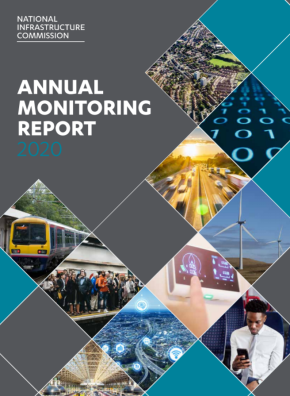National Infrastructure Commission's Annual Monitoring Report 2020
In February 2020, the National Infrastructure Commission (NIC) published its Annual Monitoring Report, assessing the Government's progress against the Commission's recommendations. The results, as ICE Lead Policy Manager Ben Goodwin discovers, are underwhelming.
[The Government's National Infrastructure Strategy will be published as part of the Budget]
Contents |
[edit] Introduction
The scope of the National Infrastructure Commission’s 2020 monitoring report takes in the progress that the Government has made against the advice set out in the six substantial studies that it has published since formation.
It is important to note that what the monitoring report does not do (at least in its entirety) is to consider the performance of the Government against the recommendations put forward in the National Infrastructure Assessment (NIA) in 2018.
The Government’s forthcoming National Infrastructure Strategy, which is to be published as part of the Budget, will be its official response to the NIA. We would therefore expect the NIC to incorporate performance against the NIA recommendations in next years’ monitoring report or through another dedicated channel.
[edit] Room for improvement in the Government’s performance
The six areas in which the NIC has assessed the Government’s performance are as follows:
- High Speed North
- Smart Power
- Transport for a World City (including Crossrail 2)
- Connected Future
- Partnering for Prosperity (specifically the Cambridge-Milton Keynes-Oxford arc)
- Data for the Public Good
The report concludes that minimal progress was made during 2019 on High Speed North, although of course it does recognise that the Government’s recent decision to greenlight High Speed 2 and ensure that it is properly integrated with Northern Powerhouse Rail is a positive step. On Crossrail 2, the commentary points to there having been limited progress throughout last year and the NIC has called for the Government to approve the revised business case for the scheme as a priority.
On smart power the report outlines the need for the Government to make more progress in enabling the development of energy storage technologies and demand side management approaches. It also suggests that progress in meeting housebuilding targets in the Cambridge-Milton Keynes-Oxford arc is not enough and that a clear strategy for addressing this shortfall should be drawn up, alongside reaching a position on the Oxford-Cambridge Expressway to ensure that improved east west connectivity is unlocked without further delay.
The report finds that the motorway network now has near universal mobile coverage for voice calls and 4G data services, but that there is a great deal of work required to bring the railways up to speed. Finally, the NIC has asked the Government to provide long-term and stable funding for the Centre for Digital Built Britain to utilise the potential of digital twin technology for the built environment sector.
[edit] Infrastructure in 2020 and beyond
Whilst the NIC’s report paints a mixed to negative picture of the performance of the Government over the last 12 months on infrastructure, there are of course a series of extenuating circumstances.
Brexit continued to cause uncertainty, whilst Government leadership changes coupled with a General Election in December meant that business as usual simply did not happen in terms of decision-making concerning the infrastructure sector.
The key thing going forward is that the Government is able to dedicate more of its time to addressing the concerns that the NIC has raised. Moreover, the forthcoming publication of the National Infrastructure Strategy represents a unique opportunity for the Government to present an evidence-based, long-term and joined-up approach for UK infrastructure provision.
If the Government can deliver a comprehensive strategy to match the impressive investment commitments that it has made, then industry will rally.
The ICE’s views on what should be included in the National Infrastructure Strategy can be found here.
This article was originally published as ‘Reflections on the National Infrastructure Commission’s Annual Monitoring Report’ on the ICE Infrastructure Blog on 28 February, 2020. It was written by Ben Goodwin, ICE Lead Policy Manager.
--The Institution of Civil Engineers
[edit] Related articles on Designing Buildings Wiki
- Budget 2020 and the first National Infrastructure Strategy.
- ICE articles.
- Interim National Infrastructure Assessment, Congestion, Capacity, Carbon.
- National Infrastructure Assessment 2018.
- National Infrastructure Commission.
- National Infrastructure Strategy.
- National Infrastructure Pipeline.
- National Infrastructure Plan.
- National Needs Assessment NNA.
- The Institution of Civil Engineers.
- What should be in the National Infrastructure Strategy?
Featured articles and news
Amendment to the GB Energy Bill welcomed by ECA
Move prevents nationally-owned energy company from investing in solar panels produced by modern slavery.
Gregor Harvie argues that AI is state-sanctioned theft of IP.
Heat pumps, vehicle chargers and heating appliances must be sold with smart functionality.
Experimental AI housing target help for councils
Experimental AI could help councils meet housing targets by digitising records.
New-style degrees set for reformed ARB accreditation
Following the ARB Tomorrow's Architects competency outcomes for Architects.
BSRIA Occupant Wellbeing survey BOW
Occupant satisfaction and wellbeing tool inc. physical environment, indoor facilities, functionality and accessibility.
Preserving, waterproofing and decorating buildings.
Many resources for visitors aswell as new features for members.
Using technology to empower communities
The Community data platform; capturing the DNA of a place and fostering participation, for better design.
Heat pump and wind turbine sound calculations for PDRs
MCS publish updated sound calculation standards for permitted development installations.
Homes England creates largest housing-led site in the North
Successful, 34 hectare land acquisition with the residential allocation now completed.
Scottish apprenticeship training proposals
General support although better accountability and transparency is sought.
The history of building regulations
A story of belated action in response to crisis.
Moisture, fire safety and emerging trends in living walls
How wet is your wall?
Current policy explained and newly published consultation by the UK and Welsh Governments.
British architecture 1919–39. Book review.
Conservation of listed prefabs in Moseley.
Energy industry calls for urgent reform.


























